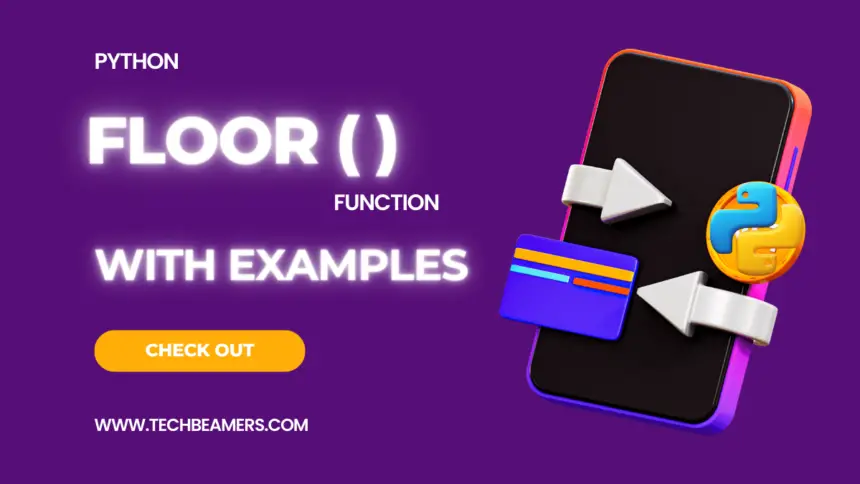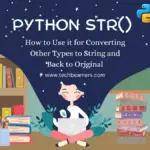The floor function in Python is a mathematical operation that rounds down a given number to the nearest integer that is less than or equal to the original number. In this tutorial, we will delve into the floor function, exploring its usage, abilities, and various methods for implementation. We will cover the basics of the floor function, its syntax, and use cases. Moreover, the examples across the tutorial will help you grasp its concept thoroughly.
Basics of the Python Floor Function
Let’s now understand how to use the floor function in Python. So, start with its syntax first.
1. Syntax
The floor function is part of the math module in Python. Here is the basic syntax:
import math
result = math.floor(x)Where x is the number you want to round down.
2. Return Type
The floor function returns an integer, representing the rounded-down value of the input.
3. Example
Let’s start with a simple example to illustrate the basic usage of the floor function:
import math
number = 7.8
rounded_down = math.floor(number)
print(f"The floor of {number} is {rounded_down}")Output:
The floor of 7.8 is 7Also Read: Convert Strings to Integers in Python
Mathematical Operations with Floor Function
Now, we need to learn when and where to apply the floor function.
1. Rounding Down Floats
The primary use of the floor function is to round down floating-point numbers to the nearest integer.
import math
float_number = 9.75
rounded_down = math.floor(float_number)
print(f"The floor of {float_number} is {rounded_down}")Output:
The floor of 9.75 is 92. Rounding Down Negative Numbers
The floor function also works with negative numbers, rounding them down to the nearest integer.
import math
negative_number = -5.2
rounded_down = math.floor(negative_number)
print(f"The floor of {negative_number} is {rounded_down}")Output:
The floor of -5.2 is -6Must Read: Using Python Map Function with Dictionaries
Use Cases and Applications
Apart from the calculations, the floor function is useful in many other Python applications. Let’s get to know them.
1. Data Analysis
In data analysis, the floor function is often used to discretize continuous data. For instance, when dealing with measurements, rounding down to the nearest whole number can simplify analysis.
import math
measurement = 15.89
rounded_down_measurement = math.floor(measurement)
print(f"The rounded down measurement is {rounded_down_measurement}")Output:
The rounded down measurement is 152. Financial Calculations
In financial applications, the floor function is useful for rounding down values related to money, such as interest rates or loan payments.
import math
interest_rate = 3.75
rounded_down_interest = math.floor(interest_rate)
print(f"The rounded down interest rate is {rounded_down_interest}%")Output:
The rounded down interest rate is 3%3. Game Development
In game development, the floor function is employed when dealing with spatial coordinates or implementing collision detection algorithms.
import math
x_coordinate = 8.3
y_coordinate = -2.7
rounded_down_x = math.floor(x_coordinate)
rounded_down_y = math.floor(y_coordinate)
print(f"Rounded down coordinates: ({rounded_down_x}, {rounded_down_y})")Output:
Rounded down coordinates: (8, -3)Check Out: Python Str Functions with Examples
Advanced Usage: Floor Division Operator
Python also provides a floor division operator (//) that can be used as an alternative to the floor function for integer division. While the floor function rounds down any numeric type, the floor division operator specifically performs integer division.
1. Using Floor Division Operator
result = 17 // 3
print(f"The result of floor division is {result}")Output:
The result of floor division is 52. Comparison with Floor Function
import math
number = 17 / 3
floor_result = math.floor(number)
floor_division_result = 17 // 3
print(f"Floor function result: {floor_result}")
print(f"Floor division result: {floor_division_result}")Output:
Floor function result: 5
Floor division result: 5Pitfalls and Considerations
1. Integer Input
The floor function is designed to work with floating-point numbers. If you provide an integer as input, the function will return the input itself.
import math
integer_input = 42
result = math.floor(integer_input)
print(f"The result with integer input is {result}")Output:
The result with integer input is 422. Precision Issues
When working with floating-point numbers, be aware of potential precision issues. Due to the inherent limitations of floating-point representation, rounding errors may occur.
import math
problematic_number = 0.1 + 0.2
rounded_down_result = math.floor(problematic_number)
print(f"The result of floor function with problematic number: {rounded_down_result}")Output:
The result of floor function with problematic number: 0Conclusion
In this tutorial, we have explored the floor function in Python from various angles, covering its basic syntax, mathematical operations, and practical applications. Whether you are working on data analysis, financial calculations, or game development, understanding the floor function’s capabilities can greatly enhance your programming skills. Additionally, we touched on the floor division operator and discussed potential pitfalls to be mindful of when using the floor function. Armed with this knowledge, you are now better equipped to leverage the floor function in your Python projects.









